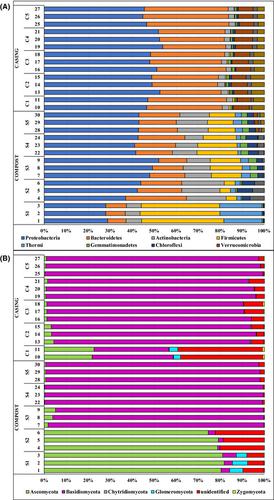当前位置:
X-MOL 学术
›
Microb. Biotechnol.
›
论文详情
Our official English website, www.x-mol.net, welcomes your feedback! (Note: you will need to create a separate account there.)
Holistic assessment of the microbiome dynamics in the substrates used for commercial champignon (Agaricus bisporus) cultivation.
Microbial Biotechnology ( IF 5.7 ) Pub Date : 2020-07-27 , DOI: 10.1111/1751-7915.13639 Jaime Carrasco 1, 2 , Carlos García-Delgado 3, 4 , Rebeca Lavega 2 , María L Tello 2 , María De Toro 5 , Víctor Barba-Vicente 4 , María S Rodríguez-Cruz 4 , María J Sánchez-Martín 4 , Margarita Pérez 2 , Gail M Preston 1
Microbial Biotechnology ( IF 5.7 ) Pub Date : 2020-07-27 , DOI: 10.1111/1751-7915.13639 Jaime Carrasco 1, 2 , Carlos García-Delgado 3, 4 , Rebeca Lavega 2 , María L Tello 2 , María De Toro 5 , Víctor Barba-Vicente 4 , María S Rodríguez-Cruz 4 , María J Sánchez-Martín 4 , Margarita Pérez 2 , Gail M Preston 1
Affiliation

|
Microorganisms strongly influence and are required to generate the selective substrate that provides nutrients and support for fungal growth, and ultimately to induce mushroom fructification under controlled environmental conditions. In this work, the fungal and bacterial microbiota living in the different substrates employed in a commercial crop (compost phase I, II and III, flush 1 and 2, and casing material on day 1, 6 and 8 after compost casing and during flush 1 and 2) have been characterized along the different stages of cultivation by metataxonomic analysis (16S rRNA and ITS2), analysis of phospholipid fatty acid content (PLFAs) and RT‐qPCR. Additionally, laccase activity and the content of lignin and complex carbohydrates in compost and casing have been quantified. The bacterial diversity in compost and casing increased throughout the crop cycle boosted by the connection of both substrates. As reflected by the PLFAs, the total living bacterial biomass appears to be negatively correlated with the mycelium of the crop. Agaricus bisporus was the dominant fungal species in colonized substrates, displacing the pre‐eminent Ascomycota, accompanied by a sustained increase in laccase activity, which is considered to be a major product of protein synthesis during the mycelial growth of champignon. From phase II onwards, the metabolic machinery of the fungal crop degrades lignin and carbohydrates in compost, while these components are hardly degraded in casing, which reflects the minor role of the casing for nourishing the crop. The techniques employed in this study provide a holistic and detailed characterization of the changing microbial composition in commercial champignon substrates. The knowledge generated will contribute to improve compost formulations (selection of base materials) and accelerate compost production, for instance, through biotechnological interventions in the form of tailored biostimulants and to design environmentally sustainable bio‐based casing materials.
中文翻译:

对商业蘑菇(双孢蘑菇)栽培基质中微生物组动态的整体评估。
微生物强烈影响并需要产生选择性底物,为真菌生长提供营养和支持,并最终在受控环境条件下诱导蘑菇结果。在这项工作中,生活在商业作物中使用的不同基质中的真菌和细菌微生物群(堆肥阶段 I、II 和 III,冲洗 1 和 2,以及堆肥覆盖后第 1、6 和 8 天以及冲洗 1 期间的覆盖材料) 2) 通过元分类学分析(16S rRNA 和 ITS2)、磷脂脂肪酸含量 (PLFA) 分析和 RT-qPCR 来表征不同培养阶段的特征。此外,还对堆肥和覆盖物中的漆酶活性以及木质素和复合碳水化合物的含量进行了量化。由于两种基质的连接,堆肥和覆土中的细菌多样性在整个作物周期中增加。正如 PLFA 所反映的,活细菌总生物量似乎与作物的菌丝体呈负相关。双孢蘑菇是定植基质中的优势真菌物种,取代了卓越的子囊菌门,伴随着漆酶活性的持续增加,漆酶活性被认为是蘑菇菌丝生长过程中蛋白质合成的主要产物。从第二阶段开始,真菌作物的代谢机制会降解堆肥中的木质素和碳水化合物,而这些成分在覆土中几乎不降解,这反映出覆土对滋养作物的作用较小。本研究中采用的技术提供了商业蘑菇基质中微生物组成变化的整体和详细表征。所产生的知识将有助于改进堆肥配方(基础材料的选择)并加速堆肥生产,例如通过定制生物刺激剂形式的生物技术干预以及设计环境可持续的生物基外壳材料。
更新日期:2020-10-05
中文翻译:

对商业蘑菇(双孢蘑菇)栽培基质中微生物组动态的整体评估。
微生物强烈影响并需要产生选择性底物,为真菌生长提供营养和支持,并最终在受控环境条件下诱导蘑菇结果。在这项工作中,生活在商业作物中使用的不同基质中的真菌和细菌微生物群(堆肥阶段 I、II 和 III,冲洗 1 和 2,以及堆肥覆盖后第 1、6 和 8 天以及冲洗 1 期间的覆盖材料) 2) 通过元分类学分析(16S rRNA 和 ITS2)、磷脂脂肪酸含量 (PLFA) 分析和 RT-qPCR 来表征不同培养阶段的特征。此外,还对堆肥和覆盖物中的漆酶活性以及木质素和复合碳水化合物的含量进行了量化。由于两种基质的连接,堆肥和覆土中的细菌多样性在整个作物周期中增加。正如 PLFA 所反映的,活细菌总生物量似乎与作物的菌丝体呈负相关。双孢蘑菇是定植基质中的优势真菌物种,取代了卓越的子囊菌门,伴随着漆酶活性的持续增加,漆酶活性被认为是蘑菇菌丝生长过程中蛋白质合成的主要产物。从第二阶段开始,真菌作物的代谢机制会降解堆肥中的木质素和碳水化合物,而这些成分在覆土中几乎不降解,这反映出覆土对滋养作物的作用较小。本研究中采用的技术提供了商业蘑菇基质中微生物组成变化的整体和详细表征。所产生的知识将有助于改进堆肥配方(基础材料的选择)并加速堆肥生产,例如通过定制生物刺激剂形式的生物技术干预以及设计环境可持续的生物基外壳材料。



























 京公网安备 11010802027423号
京公网安备 11010802027423号